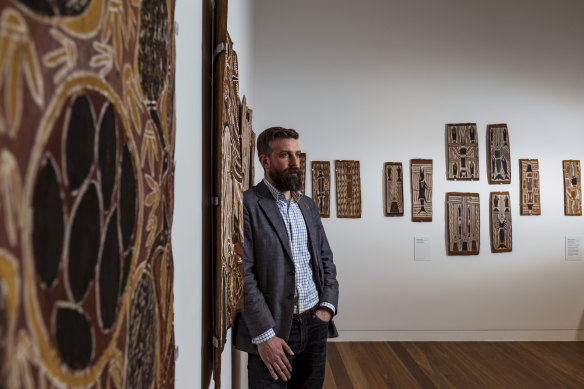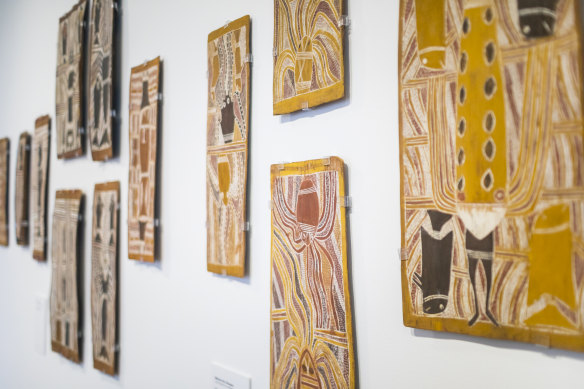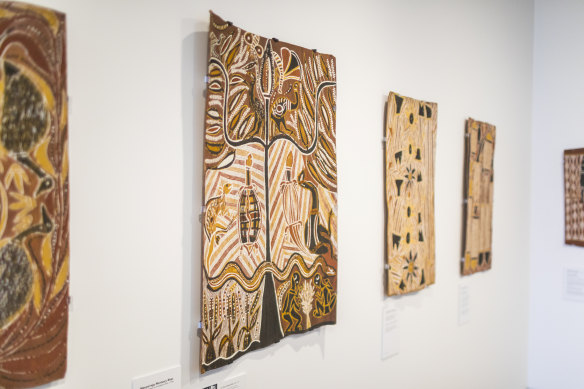This was published 4 years ago
Bark paintings from the golden period return, half a century later
By Tony Wright
More than half a century ago, a young American in search of himself drifted to the distant, unfamiliar territory of north-east Arnhem Land and fell in thrall to haunting and beautiful cross-hatched designs consigned to strips of bark by the Indigenous artists of the region.
Aged just 27, Kenneth Neybert began buying bark paintings by artists who, in a new century, would become famous.

Curator Ben Thomas at Trinity College with the bark paintings.Credit: Chris Hopkins
By the most circuitous of routes over 55 years, most of those paintings – now recognised as time capsules from the golden period of Aboriginal art in the 1950s and 60s – are back in Australia.
Revealed: Arnhem Land Barks from the Anita Castan Collection – Yirrkala and Milingimbi is the latest exhibition at the University of Melbourne's Trinity College.
Time capsule is not too extreme a description.
In the long years between Mr Neybert collecting the works and Melbourne-based investor, art collector and philanthropist Anita Castan bringing them back to Australia, a particular orchid – the resin of which was used to fix the ochre to the bark – has died out in Arnhem Land.
Ben Thomas, Rusden curator at Trinity College, said he had also discovered that some of the paintings depicted manta rays, which no longer swim by the communities that once were so familiar with the great creatures they painted.
Mr Thomas, assisted by Melbourne-based art dealer Malcolm Davidson, spent months hunting down old photographs and stories of many of the artists and the meaning of their work to ensure the exhibition at Trinity was presented as accurately as possible.
It helped also that both the father, Wandjuk Marika, OBE, and grandfather, Mawalan Marika, of Melbourne University’s community engagement officer, Mayatili Marika, painted some of the finest works in the collection. The college has long taken seriously its engagement with Indigenous communities, and has 29 Indigenous students from throughout Australia among its student body.

The exhibition includes works by Wandjuk Marika, among others.Credit: Chris hopkins
The journey of the bark paintings began when Mr Neybert, burnt out from working in the California Youth Authority among gang members and delinquents, took a relaxing sea cruise. Fellow passengers persuaded him to visit Australia, where he arrived in 1965.
His credentials earned him a job with the Northern Territory Aboriginal Welfare Department, which sent him to Milingimbi Island in far north-east Arnhem Land. And there began his love affair with Indigenous art.
The bark paintings were produced during a critical decade for the Yolngu people of far north-east Arnhem Land. In 1963, the federal government was presented with the Yirrkala bark petition, the Yolngu’s declaration of traditional ownership after the government had granted rights to bauxite mining company Nabalco on the Gove Peninsula without consulting the traditional owners.
There followed an eight-year-long legal battle known as the Gove land rights case. The case eventually failed in 1971, but it paved the way for the famous overturning of the legal concept of terra nullius in the 1992 Mabo case.

The paintings come from a golden era for Indigenous art.Credit: Chris Hopkins
When he returned to the US, Mr Neybert owned what was among the earliest and most substantial collections of Aboriginal bark paintings outside Australia.
It proved to be too early to make a go of the gallery he opened in Los Angeles to showcase Australian Indigenous art.
But he did not part with the bark works he had collected in Arnhem Land until some time about 2000, when he put his collection up for sale, hoping an Australian buyer could be found.
Anita Castan bought the lot.
Here was a circularity to this long story.
Ms Castan is the sister-in-law of the late barrister Ron Castan, QC, who was senior counsel in the Mabo case and one of the lawyers involved in the original Gove land rights case, which was triggered by that old bark petition.
The exhibition at Trinity College is open Tuesdays and Thursdays, 10am-4pm, until September 5.